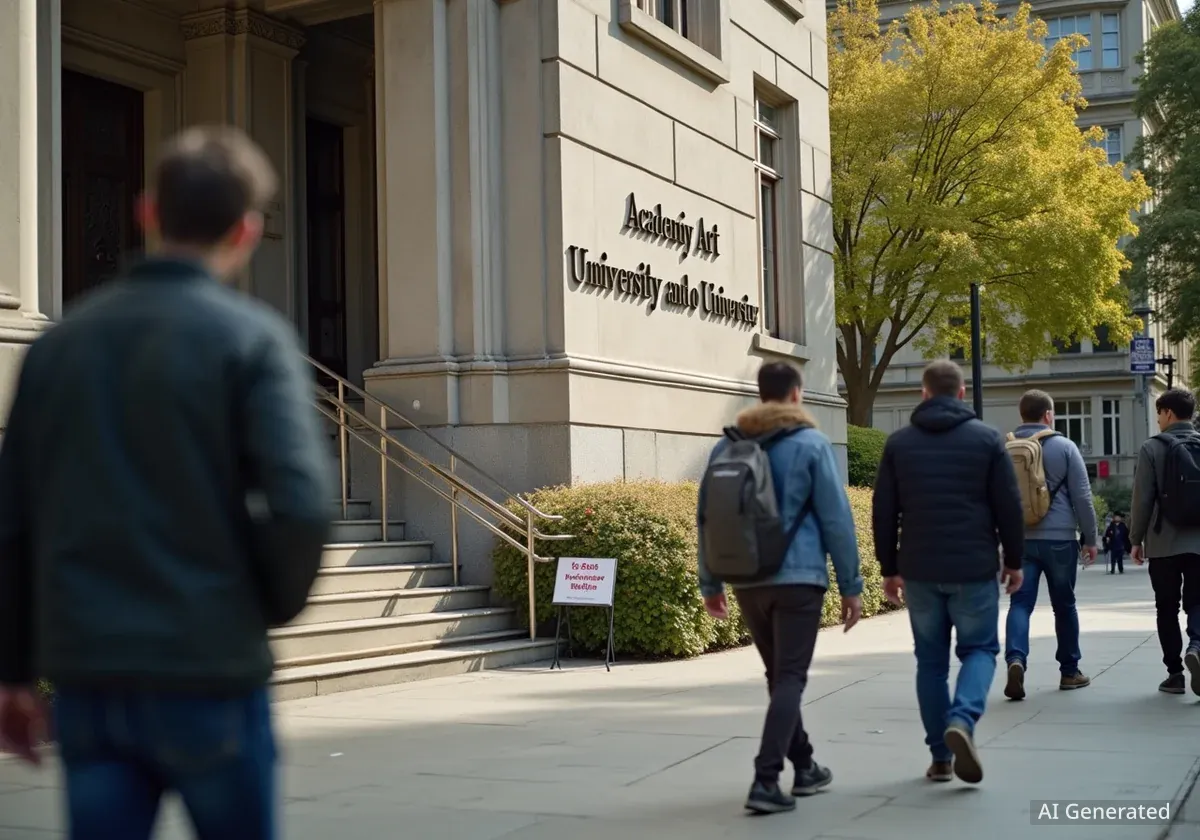San Francisco's Academy of Art University has listed 10 properties for sale across the city, totaling nearly 375,000 square feet. This move comes as the private art institution works to manage its extensive real estate portfolio, a significant development for one of the city's largest property owners.
Key Takeaways
- Academy of Art University is selling 10 properties in San Francisco.
- The listed buildings cover almost 375,000 square feet.
- Notable properties include St. Brigid Catholic Church and the Concordia-Argonaut Club.
- The university previously settled a $60 million lawsuit with the city over zoning and housing issues.
- This sale follows the termination of all athletic programs due to financial sustainability concerns.
University Adjusts Real Estate Strategy
The Academy of Art University, a prominent institution in San Francisco, has initiated a major real estate divestment. The university listed 10 of its properties for sale on Tuesday, marking a substantial shift in its operational strategy. These properties are spread throughout various parts of the city.
This decision follows a period of financial re-evaluation for the university. In April, the school announced the termination of all its athletic programs, citing concerns about their financial sustainability within the university's budget. This earlier move signaled a broader effort to streamline expenditures and focus resources.
Quick Facts
- Total Square Footage: Approximately 375,000 square feet across 10 properties.
- Notable Listing: St. Brigid Catholic Church, built in 1902, listed for $7 million.
- Previous Sale: The Commodore Hotel, a student housing property, sold earlier this month for $13 million.
Iconic Buildings Among Listings
Several of the properties now on the market are well-known landmarks and significant structures within San Francisco. Six of the listed buildings are situated along Van Ness Avenue, a major city thoroughfare. Among these is the historic St. Brigid Catholic Church, constructed in 1902.
The St. Brigid Catholic Church, located at 2151 Van Ness Avenue, holds particular historical value. It is listed with an asking price of $7 million. Other notable properties along Van Ness Avenue include the extensive 52,475-square-foot Concordia-Argonaut Club and a distinctive large pink building at the intersection of Van Ness Avenue and Jackson Street.
"We've determined that these programs are no longer financially sustainable within our university budget," said Chris Visslailli, the Academy of Art's chief of staff, regarding the earlier decision to end athletic programs.
Diverse Locations Across the City
Beyond Van Ness Avenue, the university has listed properties in other key areas. These include a nearly 72,000-square-foot space at 701 Chestnut Street, situated near the popular Fisherman's Wharf district. Another significant listing is an 80-unit building located at 1055 Pine Street in Lower Nob Hill.
The sale of these properties marks a considerable divestment for the institution. Earlier this month, one of the university's student housing facilities, the Commodore Hotel on Sutter Street, was sold for $13 million, indicating a consistent trend in property sales.
Background on Academy of Art University
Founded in 1929 by Richard S. Stephens, the Academy of Art University began modestly from a loft at 215 Kearny Street. It has since grown into a substantial educational institution, remaining a family-operated business under the leadership of Stephens' granddaughter, Elisa, who serves as its current president.
By the 2010s, the university had amassed a significant real estate portfolio, owning over 40 buildings across San Francisco. These properties served various purposes, including campus facilities and student housing. This extensive ownership made the university a major player in the city's property landscape.
Past Legal Challenges and Growth
The university's extensive property holdings have not been without challenges. In 2016, the City of San Francisco initiated a lawsuit against the institution. The lawsuit alleged that 33 of the university's properties were not compliant with existing zoning codes, signage regulations, or historic preservation rules.
Furthermore, the legal action claimed that the Academy of Art University illegally converted 160 affordable rental units into student housing. This lawsuit was eventually settled for a sum of $60 million, highlighting the scale of the compliance issues and the financial implications for the university.
The current sale of properties could be seen as a strategic response to ongoing financial pressures and a broader effort to optimize the university's asset base. Managing such a large and diverse portfolio in a city with complex real estate regulations presents unique challenges.
Impact on San Francisco Real Estate
The availability of nearly 375,000 square feet of institutional property on the market could have an impact on San Francisco's real estate sector. The sale includes a variety of building types, from historic landmarks to large commercial spaces and residential units. This influx of properties offers new opportunities for developers and investors in the city.
The divestment reflects a changing landscape for private educational institutions in urban environments, often balancing operational costs, regulatory compliance, and the need for modern facilities. The university's decision to offload these assets suggests a focused approach to its core mission while adapting to economic realities.
- The properties are diverse, including a church, a club, and residential units.
- This sale adds significant inventory to the San Francisco market.
- It reflects the university's ongoing efforts to manage its finances and property portfolio.
The Academy of Art University continues to be a key educational institution in the city. Its strategic real estate decisions will likely influence its future operations and its footprint within San Francisco.





